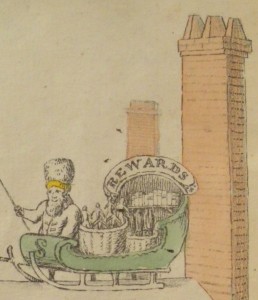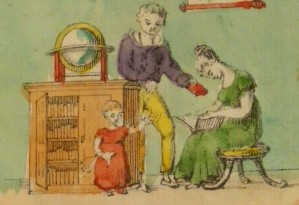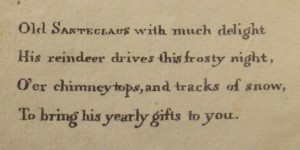AAS’s The Children’s Friend: A New Year’s Present is one of just two known copies of the 1821 pamphlet. Fifteen centimeters tall and eight pages deep, the paper-covered volume stood little chance of survival in the hands of generations of American children. But there was one family fastidious enough for the task, and by chance they would be among AAS’s most important benefactors.
The Salisbury family provided AAS, notably, with two of its presidents, 67 boxes and an additional 100 bound volumes in manuscript materials, and the land for the library’s current home. In 1897 the Society also received the childhood book of one of those presidents, Stephen Salisbury III. Six-year old Stephen received The Children’s Friend in 1841 as a gift from Kitty Lawrence.
What makes this little book so important? Put simply it is believed to be the first American Christmas picture book. But we asked Laura Wasowicz, Curator of Children’s Literature, and Gigi Barnhill, Director of CHAViC for a few more details.
 ~The publishing location, New York City, is important. The brick chimneys visible as “Old Santeclaus” lands his sleigh indicate an urban environment.
~The publishing location, New York City, is important. The brick chimneys visible as “Old Santeclaus” lands his sleigh indicate an urban environment.
- ~The pamphlet falls within a set of attempts by well-to-do New Yorkers to domesticize the holiday from a time for rowdy alcohol-infused parties and mob revelry to a safe, family-focused holiday. The Children’s Friend joined efforts by New York Historical Society founder John Pintard and Clement Clarke Moore (author of the poem “A Visit from St. Nicholas” first published in 1823).*
- ~The story offers the first visit by St. Nicholas on Christmas Eve (instead of his Saint’s day December 6th), as well as the first appearance of his reindeer.
- ~While the “long, black birchen rod” left for parents with naughty sons might seem a harsh ending to modern readers, it was in keeping with the parlance of the day. In a time when a children’s book might conclude with a child burned to death for playing too close to the fire, The Children’s Friend is in fact a gentle cautionary tale.
 ~The Children’s Friend is considered the first American example of a completely lithographed book. Lithography (the practice of drawing on limestone with waxy crayons to create a master image that absorbed ink) was introduced in the United States in the early 1800s.
~The Children’s Friend is considered the first American example of a completely lithographed book. Lithography (the practice of drawing on limestone with waxy crayons to create a master image that absorbed ink) was introduced in the United States in the early 1800s.
- ~Unlike engraving, lithography did not require the same high level of skill to execute and could make up to 100,000 impressions with one stone. But the technology did require special equipment and a specific type of printing press.
- ~Barnet and Doolittle, the firm that likely lithographed the pamphlet, was the first commercial lithographic printing shop to be established in the U.S.
 ~The publishers used lithography as an inexpensive alternative to engraving and avoided the expense of multiple presses by lithographing both illustration and text (you can see that the text looks handwritten).
~The publishers used lithography as an inexpensive alternative to engraving and avoided the expense of multiple presses by lithographing both illustration and text (you can see that the text looks handwritten).
- ~The color, added by hand after printing, suggests the pamphlet was expensive to buy.
*Historian Stephen Nissenbaum discusses The Children’s Friend and explores the transition to a family-oriented holiday in The Battle for Christmas (New York, 1996). Nissenbaum did much of his research at AAS as a long-term fellow.




One thought on “Santa Claus Exposed”